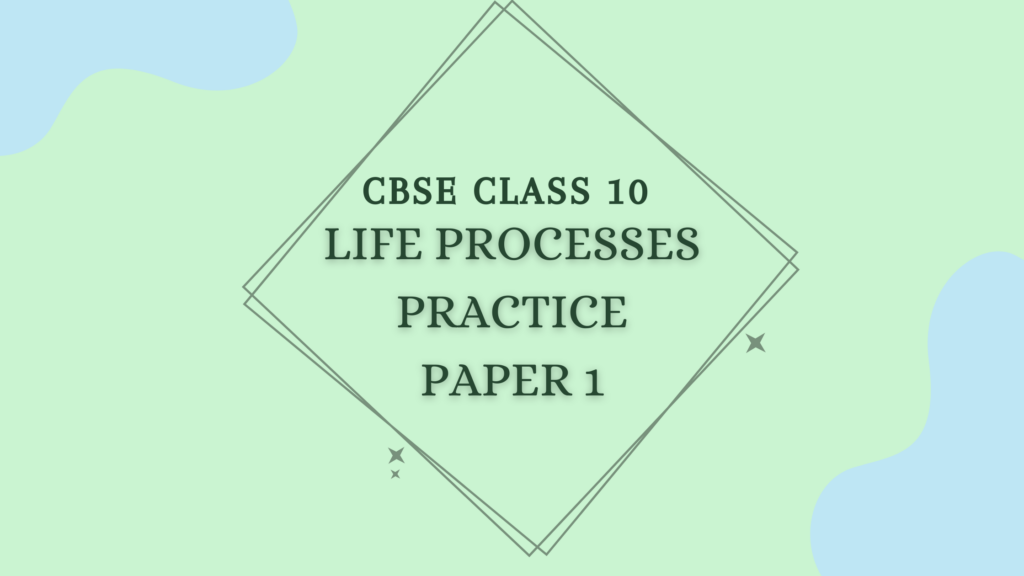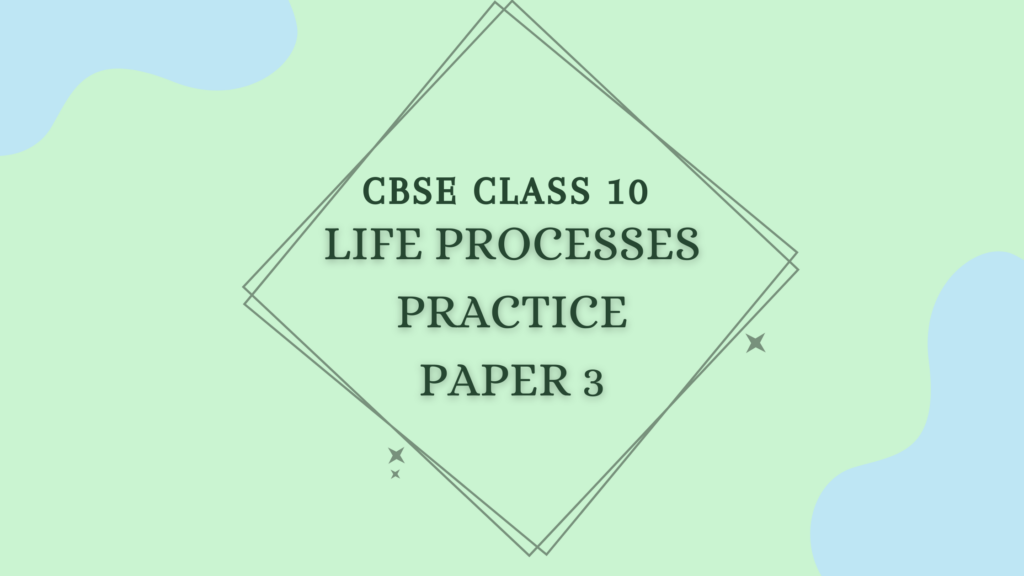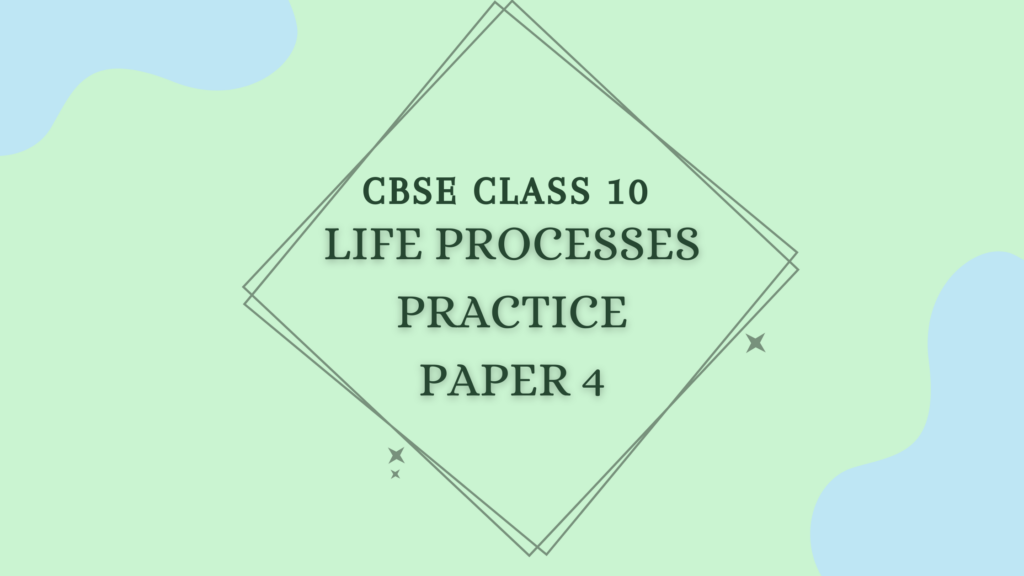Class 10 Life Processes Practice Paper 1
Time: 1 hr
Marks: 30
Section-A Choose the Correct Option 5 x 1=5
1. The instant source of energy.
a. Sucrose
b. Fats
c. Glucose
d. Amino acids
2. Which part of the nephron allows the selective reabsorption of useful substances like glucose, amino acids, salts, and water into the blood capillaries?
a. Tubule
b.Glomerulus
c.Bowman’s capsule
d. Ureter
3. Lipase acts on
a. Amino acids
b. Fats
c.Carbohydrates
d. Urea
4. What is common between the extensive network of blood vessels around the walls of alveoli and in glomerulus of the nephron?
a. Thick-walled arteries richly supplied with blood
b. Thin-walled veins poorly supplied with blood
c. Thick-walled capillaries poorly supplied with blood.
d. Thin-walled capillaries richly supplied with blood
5. Assertion: The muscular walls of ventricles are thicker than auricles.
Reason: This helps in preventing the backflow of blood.
a. Both Assertion and Reason are true, and Reason is the correct explanation of the assertion.
b. Both Assertion and Reason are true, but Reason is not the correct explanation of the assertion.
c. Assertion is true, but Reason is false.
d. Assertion is false, but Reason is true.
Section-B Very Short Answer Questions 3 x 2=6
6. a. What forms the peripheral nervous system?
6b. Which type of nervous system controls and regulates the functions of the internal organs of our body involuntarily?
7. State the significance of emulsification.
8. How does the small intestine absorb digested food?
Section C- Short Answer Questions 2 x 3 = 6
9. Differentiate between aerobic and anaerobic respiration.
10. Name the end products formed during:
(i) Oxidation of glucose in the muscles
(ii) Oxidation of glucose in body cells
(iii) Breakdown of glucose anaerobically.
Section D- Short Answer Questions 1 x 5 = 5
11. Define photosynthesis. Write the equation and explain the steps.
Section – E Case Study Questions 2 x 4= 8
12. Read the following and answer any four questions (i) to (v)
Heterotrophic nutrition is a mode of nutrition in which organisms depend on outside sources for organic food. Such organisms are called heterotrophs. Heterotrophic nutrition has three types: saprophytic, parasitic, and holozoic.
(i) Identify the group of organisms in which the food material is broken down outside the body and absorbed.
(a) Mushroom, green plants, Amoeba
(b) Yeast, mushroom, bread mold
(c) Paramecium, Amoeba, Cuscuta
(d) Cuscuta, lice, tapeworm
(ii) Which of the following is a parasite?
(a) Yeast
(b) Taenia
(c) Amoeba
(d) Earthworm
(iii) Which of the following is an example of a saprotroph?
(a) Grass
(b) Mushroom
(c) Amoeba
(d) Paramecium
(iv) Heterotrophic nutrition involves
(a) production of simple sugar from inorganic compounds
(b) utilization of chemical energy to prepare food
(c) utilization of energy obtained by plants
(d) all of the above
(v) In Paramecium, food enters the body through
(a) mouth
(b) pseudopodia
(c) cilia
(d) cytostome
13. Read the following and answer the questions.
In many biological processes, water is an important chemical, required as the solvent. It is needed as raw material in photosynthesis, as the main substance from which plants evolve oxygen and provide hydrogen for synthesizing carbohydrates. Water helps translocate chemical substances and minerals. Osmosis is a special type of transport of water molecules that occurs through a semipermeable membrane. It is the movement of solvent from the region of higher diffusion pressure to the lower diffusion pressure across a semipermeable membrane. There are two types of osmosis – endosmosis and exosmosis. Endosmosis is the osmotic entry of water into a cell, organ, or system. Exosmosis is the osmotic withdrawal of water from a cell, organ, or system.
(i) A flowering plant is grown in an earthen pot. Urea is added in high amounts to make the plant grow faster, but after some time the plant dies, due to
(a) exosmosis
(b) endosmosis
(c) waterlogging
(d) suffocation.
(ii) A slice of sugar beet placed in a concentrated salt solution would
(a) show no change
(b) loose water and become flaccid initially
(c) absorb small quantity of water
(d) become swollen.
(iii) The process of diffusion is involved in
(a) respiration
(b) photosynthesis
(c) transpiration
(d) all of these
(iv) The cytoplasm of a plant cell is surrounded by a cell wall and a cell membrane. The transport of substances is mainly across the cell membrane, because
(a) Cell membrane is impermeable
(b) Cell membrane is selectively permeable
(c) Cell membrane is fully permeable
(d) Cell wall is impermeable.



